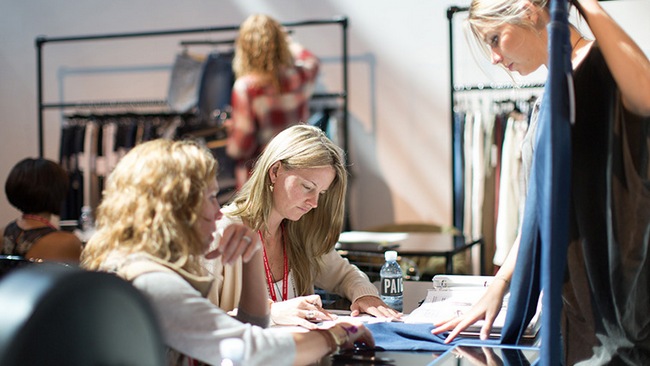
Trade shows offer ample opportunities for expanding the business network, if you know how to work them right (image by by Cristina Boydell via fajomagazine.com)
Many companies become reluctant to participate in trade shows after a couple of tries end up costing them more than they gain in return. However, despite the fact that exhibiting can be expensive, it’s still a great way to showcase your designs, grow awareness of your brand, size up competition, gain new business insights, establish useful industry partnerships, and even close deals. So we’ve put together some tips to help you make the most out of your trade show investment.
1. Choose the right show
Since participating in an industry event is first and foremost about obtaining qualified leads, you have to make sure that the chosen trade show corresponds to your business niche and attracts the right kind of audience. Research the organizers, sponsors, speakers, other exhibitors, as well as the event schedule. If you’re not excited about being part of the event, you won’t convince others to attend. Ideally, you shouldn’t participate in a show that is unlikely to pay for itself in terms of gained revenue.
2. Build awareness and excitement early on
To make your participation in a trade show a success, go out of your way to attract the right kind of traffic to the event in general and to your booth in particular. Advertise the show via social media, send out a news blast to your e-mail list, and promote the event in any other way that you see fit.
Also, identify your target prospects (buyers, stores, other vendors) and reach out to them, setting up appointments beforehand. A special collection presentation, or an exclusive trade show deal will give attendees all the more reason to check out your booth.
3. Be prepared
Identify your goals for the show and make sure all your staff members know what they are. You all have to be on the same page in terms of strategy, so that your employees are consistent in the way they present the brand. Knowing your collection in and out is a must. You have to be able to answer any buyers’ questions regarding prices, color options, style numbers, size range, deliveries, and so on without checking papers. Keep in mind that trade shows are not the place to offer one-offs.
When it comes to setting up your booth, communicate your location preferences to the organizers to maximize the chances of securing a spot that suits your needs. Being next to “alike” brands is also a good idea. That way you can benefit from your competitors’ traffic and attract buyers who are interested in the products you have to offer.

Engage with prospects one-on-one to best identify and cater to their needs (image via cargocollective.com)
4. Focus on prospects
Even if you participate in the event that draws an audience of 15,000 people, it won’t translate into any financial gains for you unless you engage with the attendees. Start with the overall atmosphere in your booth. Organize your exhibit space so that it’s inviting. Be friendly and accessible – smile, show your enthusiasm to be at the event, don’t eat or drink in front of potential customers, or they will think you’re too busy to talk. Idly sitting in the booth also looks unwelcoming.
Strive to make meaningful connections with people. In conversation, gently probe attendees for their interests and needs, and demonstrate how your designs can help them achieve their goals. Don’t let prospects go without leaving their contact details, or better yet, setting up an appointment.
Note that the end of the show day, when all the hustle and bustle subsides, may be the best time to engage with buyers on a personal level. So make sure you don’t lose your steam as the trade show progresses.
5. Be quick and efficient with paperwork
Have all the marketing collateral, as well as contract terms, forms, invoices, and other documents at hand. By handling inquiries and paperwork expediently, you’ll demonstrate your professionalism and goodwill, and make a positive impression on a buyer as they consider entering into a vendor relationship with you.
Put an efficient and transparent lead management system in place, so that your team can quickly record, categorize and process leads as they come.
6. Follow up, follow up, and follow up once again
Most important of all, get back to prospects as soon as you can to close deals while the excitement is still high. Send requested materials, respond to questions, set up meetings to discuss further collaboration. If you don’t have enough information to craft a personalized e-mail or place a phone call, hit your potential clients with an engaging newsletter that contains useful information or helpful links. It takes up to 10 contacts to make prospects notice and respond, so don’t get discouraged if it doesn’t work out right away.




About The Author: BridgeShowroom
Since 2011, BRIDGE SHOWROOM has been representing Europe's finest designers in America.
We are partners, linking together retailers and designers.
More posts by BridgeShowroom